I have a bone to pick, but I’m not precisely sure with whom.
Allow me to present the Three Graces at the Louvre, a gorgeous sculpture that I personally love.
Look at this rather stunning basalt Aphrodite from ca. 1st-2nd century AD!
Or this stunning, relatively typical sculpture of Aphrodite (she’s currently on the market—check out Christie’s if you want to hurt yourself).
So what’s wrong with this picture? (I assume you’ve read the title so you get minimal points for guessing).
Michael Squire summarises my bone-picking perfectly:
“Classical art has been almost universally celebrated for its ‘lifelike’ naturalism… Graeco-Roman bodies are lauded for their believability. When it comes to the female body, though, desirability seems to have been figured around a very different rhetoric - a fractured fiction of femininity, premised on the wholly unconvincing absence of pubic hair and genitals.”
I call it the ken-doll effect.
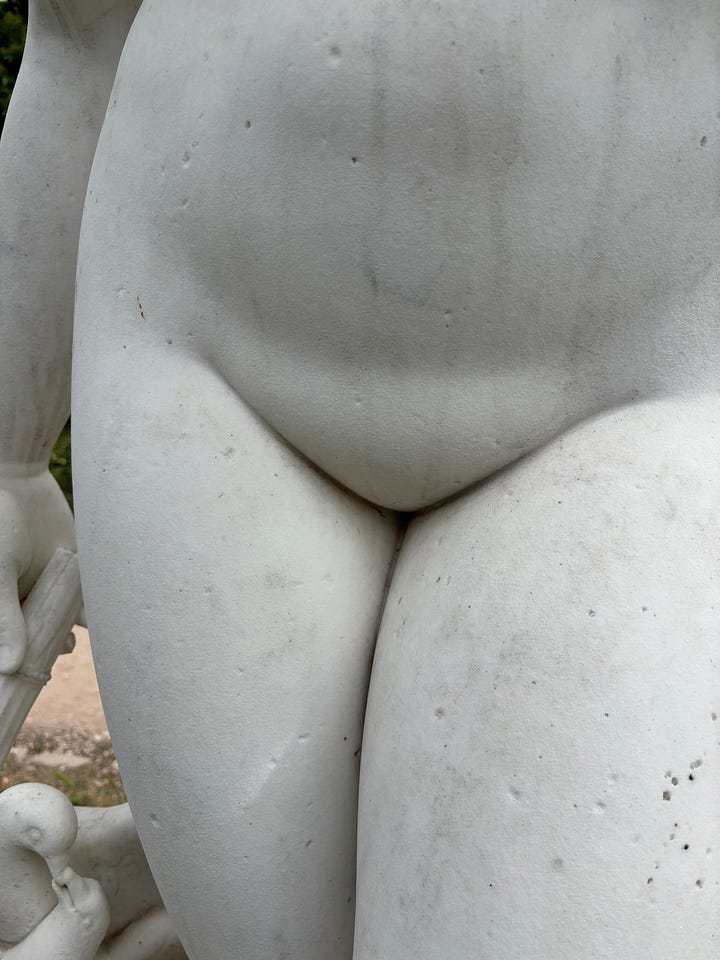

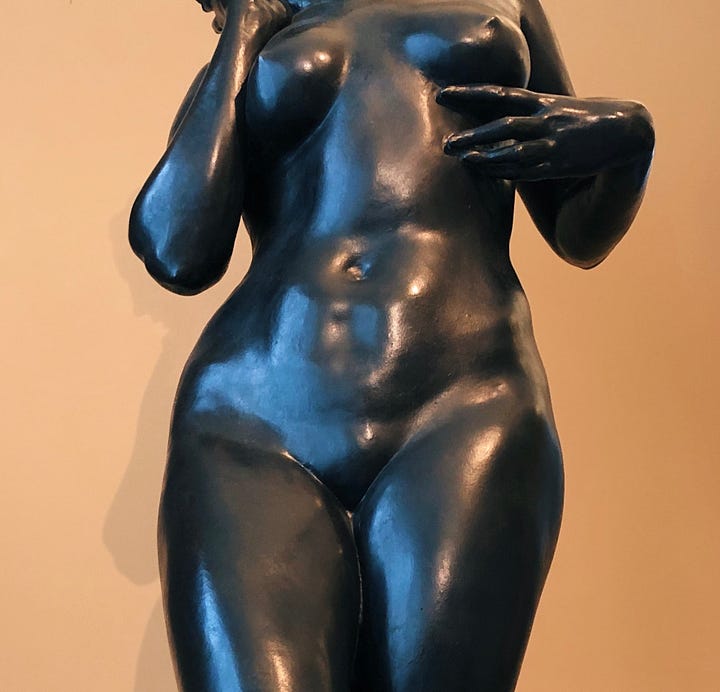
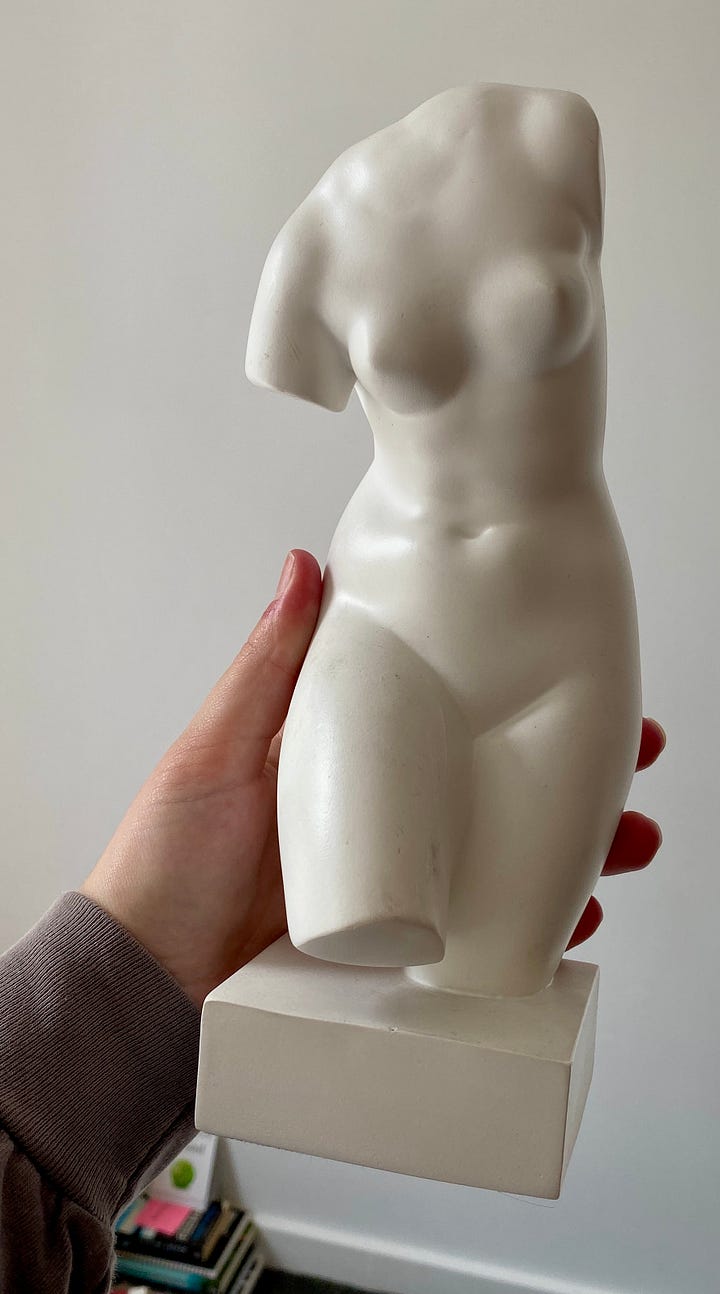
This brings us to the TLDR:
A hyper-specific part of the (heavily memed) unrealistic body standards for women can be traced all the way back to 350 BCE.
So what the hell is going on? Have you ever noticed this?? Do you think it’s weird??? (These questions are not rhetorical, I am genuinely very curious).
Surprise surprise this glaring artistic omission did not come up during either of my degrees but a cursory google reveals that I am not the first person to have my mind boggled by this. Syreeta McFadden wrote a piece for the Guardian and described the state of affairs rather elegantly: “there are but modest dents around the pelvic bones of the statues, but no openings or slight separations of the pelvic mounds to be found anywhere.” I’ve never been 100% behind the use of mound as a descriptor but it’s perhaps less jarring than the alternative.
Christian-Georges Schwentzel’s piece, titled When did the vulva become obscene? provides ancient historical context, stating that earlier civilisations like the Sumerians were far more relaxed or artistically faithful when it came to female genitalia but, as his subtitle states, In Greece and Rome: the vulva vanishes.
So… WHERE DID IT GO????
Lydia Schriemer, in her discussion of nudity and Greek sculpture, writes “In [ancient] literature, no direct mention is ever made of the female genitals; they are instead referred to as aidoia.” Nanette Salomon, talking about more modern examples, explains that, “The word pudica is etymologically related to pudenda meaning both shame and genitalia. This unfortunate combination goes back to the doubled meaning of the Greek root word aidos, aidoios,” meaning shame or modesty.
So we’ve got a real clusterf*ck of etymology here but if, like me, that’s not really your area, allow Michael Squire to translate:
“In this physical place above all others, female bodies constitute a taboo that male bodies do not: the female pudenda manifests a visual embarrassment, and one that has translated into a western cultural taboo at large.”
When I first started looking into this (typing vulva into JSTOR and seeing what fell out), I came across this article written back in 1934 that declares, “In all sculpture, whether primitive or advanced, it is exceptionally difficult to represent the female genitalia.” I’m not a sculptor but I have to call bullshit on this.
Also, I feel that pointing out the double standard almost goes without saying, but you cannot swing a CAT (in a museum or gallery) without hitting a rather small, flaccid penis attached to a god, hero, etc. And of course it looks like their bush has just had a deep conditioning treatment and a fresh blow out — that’s a whole other row that we can have later but for now read this piece by
:I will concede, however, that marble sculptures depicting the female form didn’t suffer through the whole fig-leaf debacle. So that’s something. Maybe. Again, a row for another time, but if you’re curious check out
’s piece:So… what is so unbearable about the appearance of female genitalia?
Even in 2025 you’d be hard pressed to find a woman who didn’t feel at least somewhat self-conscious about her see-you-next-tuesday.
And on top of THAT, we have to contend with the fact that these sculptures, lauded for centuries as the epitome of physical perfection and beauty, don’t even have one??? It’s not like they depict vulvas that happen to be small and perfectly symmetrical which would undoubtedly still give women a complex (modern, mainstream porn I am looking at YOU). These sculptures just don’t have female genitalia, relaying the rather loud message that whatever the hell it looks like, no one wants to see it.
There’s a whole pile of scholarly hullabaloo about the way the Knidian Aphrodite simultaneously hides and draws attention to her pubic region with her hand placement:
I find it baffling that there’s so much discussion about this specific sculptural detail, but scholars haven’t necessarily clocked that she’s covering a blank mound of flesh. Or, if they have, they just accept it as a given. Also, in what twisted f*cking universe does Aphrodite, the goddess of love and SEX, not have female genitalia???
Another Aphrodite for your viewing pleasure/for me to yell about:
What’s she pointing at? Well, we know for sure it’s not her bits because she DOESN’T HAVE ANY.
Ultimately, I want to yank at this particular thread of our artistic and cultural inheritance bestowed by the ancient Greeks and Romans. This glaring omission could be easily ignored and therefore tacitly accepted (speaking as someone who has been doing just that for the last decade. It’s been a real frog in the pot moment for me).
Indulge me as I quote Michael Squire for a third and final time:
“[I]n contrast to the allure of the masculine, the desirability of western women is premised upon the specific elision of the natural.”
Whether it’s getting a Brazilian wax, undergoing permanent laser hair removal (which many women have come to regret now that the bush is experiencing a renaissance), or having vaginoplasty, this is a clear and irrefutable example of how Classical art—and ancient history more broadly—echo across the centuries, defining what is considered beautiful and, more importantly, what is not.
When will it end????
Stay tuned for my next newsletter because I may be sitting on the exception that proves the rule… 👀 Baubo figurines are very much NSFW and derive from one of the most ABSURD moments in ancient myth (the story appears in both Greek and Egyptian mythology, and I cannot wait to fling every bit of it at you).
xxxxxxxxxxxxxxxxxxxxx
Sources
McFadden, Syreeta, “The lack of female genitals on statues seems thoughtless until you see it repeated.” www.theguardian.com/commentisfree/2015/apr/13/absent-female-genitals-art-repeated
Salomon, Nanette. “Making a World of Difference: Gender, Asymmetry, and the Greek Nude,” pages 197-219 in NAKED TRUTHS: Women, Sexuality, and Gender in Classical Art and Archaeology, eds. by Ann Olga Koloski-Ostrow and Claire L. Lyons, 1997.
Schriemer, Lydia. Undressing the Female Nude: The Paradox of Morality in Ancient Greek Sculpture.
Schwentzel, Christian-Georges, “When did the vulva become obscene?” theconversation.com/when-did-the-vulva-become-obscene
Squire, Michael. The Art of the Body: Antiquity & its Legacy. I.B. Tauris, 2011.







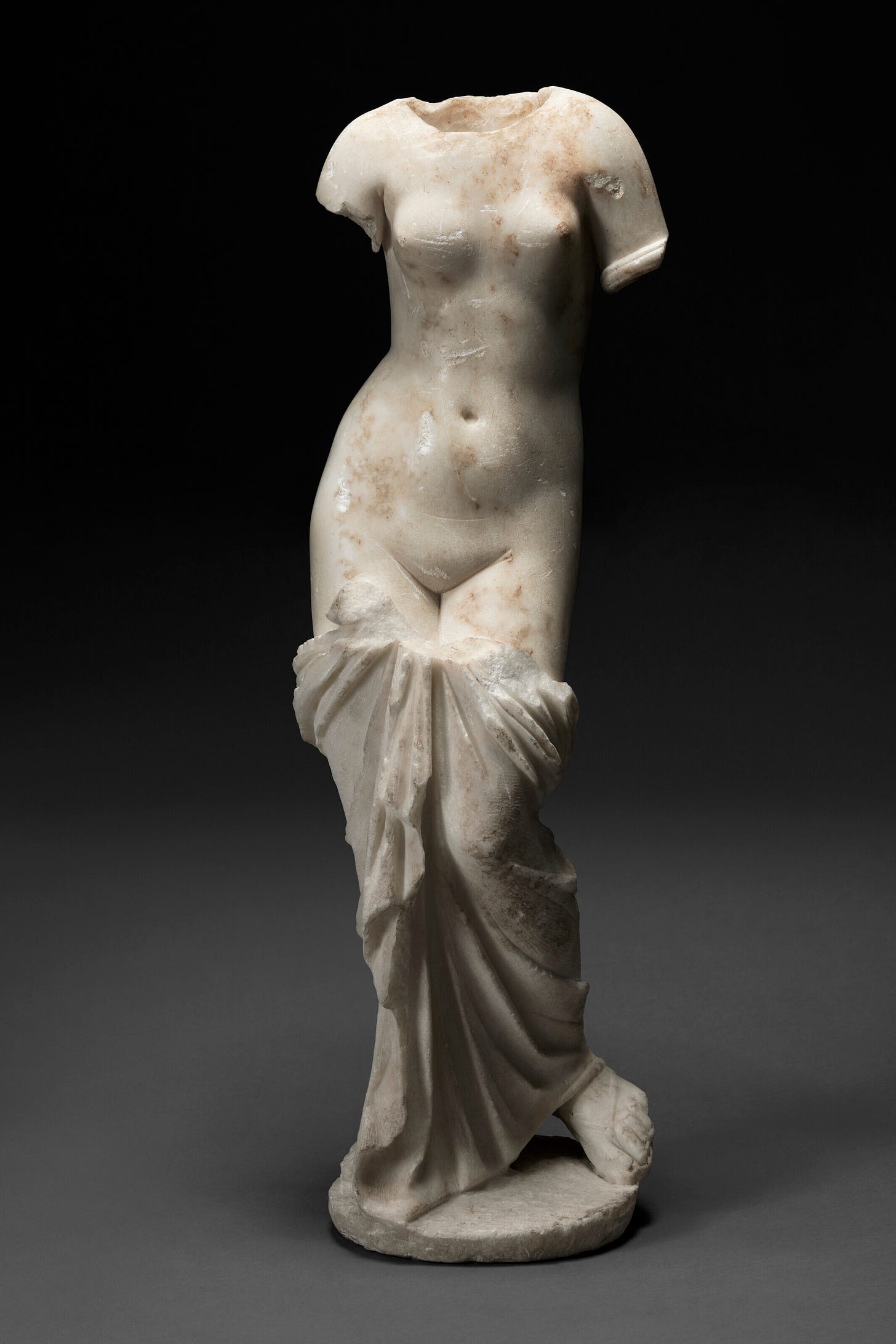




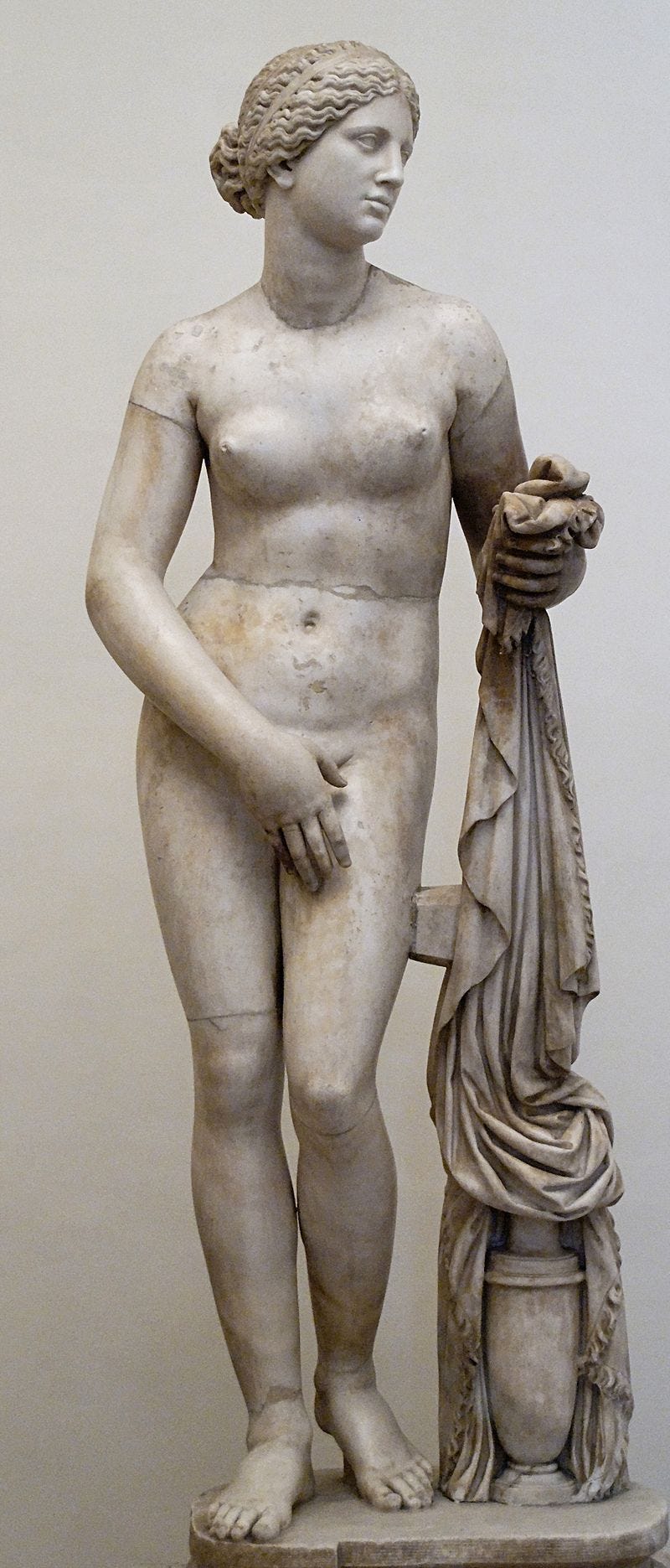



I have never noticed this but you're absolutely correct. I wonder if it has anything to do with the move away from fertility cults to more masculine dominated religion? Depicting a woman without sex organs is certainly one way to downplay the importance of childbirth.
Just so you know, this article made me subscribe! Fantastic headline! Brilliant article.